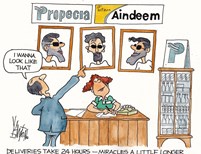Posted 14 October 2015
HAIR TODAY; GONE TOMORROW. 
The distressing condition of men’s hair loss and
the latest remedies
There are different types of hair loss or alopecia but
androgenic alopecia, commonly known as male-pattern baldness accounts for more
than 95% of hair loss in men. It’s a genetic hair loss condition and usually
begins with a receding hairline followed by thinning of the hair on the crown
and temples to form a horseshoe shape.
For more information about hair loss treatments for men, click here.
Alopecia may not be life threatening but it can be very
distressing to those affected. People who haven’t experienced it may be inclined
to see it as a purely cosmetic issue but for many sufferers it destroys their
confidence which can lead to depression and create terrible stress.
About half of all men will be affected by male pattern
baldness at some point in their lives.
Another type of alopecia that has become more prevalent
recently is traction alopecia. It is caused by excessive pulling or tension on
hair shafts as a result of certain types of hairstyle. It used to be seen more
often in women, particularly those of East Indian and Afro-Caribbean origin,
due to braiding their hair. However, there is a popular hairstyle for men that
is trending at the moment , the “man-bun” or “top-knot”, sported by celebrities such as Leonardo
DiCaprio, Jared Leto and Harry Styles. Here the hair is tightly scraped back
and if you wear it like that all day, every day then it puts long term stress
on the hair, pulling the follicle and damaging the root, pulling it out. It's just like plucking an eyebrow hair where
if you keep plucking it, it won't grow back.
Another at-risk group is men who suffer baldness on the top
of the head and so they pull the remainder back into a ponytail. This again causes
tension on the root leading to even more hair loss.
Furthermore, Sikh men who tie their hair up tightly under
their turban may cause traction alopecia.
However, the good
news is that traction alopecia is relatively rare, even for men who regularly sport
man buns. Therefore, I suggest that those who want to have a bun hairstyle,
should style their hair into a looser bun. Also, it’s best to use a soft,
snag-free elastic which is kinder to your hair, like a scrunchie.
The latest research into hair loss treatments involves hair
cell cloning. The technique takes small amounts of a person's remaining hair
cells, multiplying them, and injecting them into bald areas. Cloning is
intended to treat both male- and female-pattern baldness. However, the science
behind the technique is new and more trials are needed before it can be fully
assessed.
Another potential treatment for male pattern baldness is a
pioneering technique involving wound healing. The process involves creating a
very minor “wound” on the scalp that subsequently allows the formation of new
hair follicles.
However, at the moment, the two main treatments available
for male-pattern baldness are minoxidil and finasteride.
Minoxidil is available over the counter from pharmacies
without a prescription. It takes the form of a foam or solution that can be
rubbed into the scalp on a daily basis. It comes in two strengths containing 5%
or 2% of minoxidil. Women are recommended only to use the 2% solution and the
evidence is mixed as to whether men benefit from using the higher strength.
However, side-effects are more likely with the higher strength which involves scalp
itchiness or dryness. Also, the treatment seems to be more effective for female
pattern baldness. It takes a few months for signs of regrowth to appear and the situation will revert back to the
start if treatment is stopped.
Finasteride is a daily tablet treatment for only men with
male pattern baldness. It prevents testosterone from being converted to
dihydrotestosterone(DHT). DHT is responsible for shrinking the hair follicles
and therefore they return to their normal size, allowing natural re-growth.
About 90% of men see either increased
hair growth or prevention of further hair loss. It usually takes between 3-6
months before any effect is seen and hair loss will start again within a year
if treatment is stopped. This treatment is recommended by many hair transplant surgeons as the most effective way to encourage hair regrowth.
For more information on Finasteride hair loss treatment for men click here.
At Webmed Pharmacy we can supply finasteride treatment,
after completing a short medical questionnaire that our doctor will review and
it will be discreetly delivered the next day, in a 1 hour time slot , by dpd .
Webmed Pharmacy specialises in treatments where patients may feel embarrassed or awkward talking to their GP; or simply find it difficult to get an appointment; or aren't able to take time off from work.
If you would like to see what other treatments Webmed can provide, please click here.
Medically reviewed by: Super intendent pharmacist Margaret Hudson BSc(Hons)MRPharmS 14/10/15
Posted in Hair Loss, Men's Health